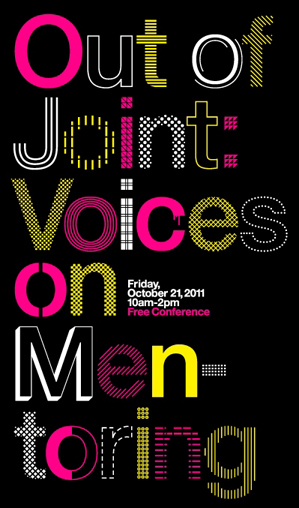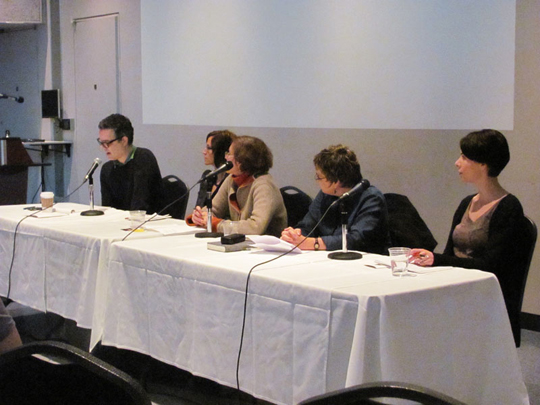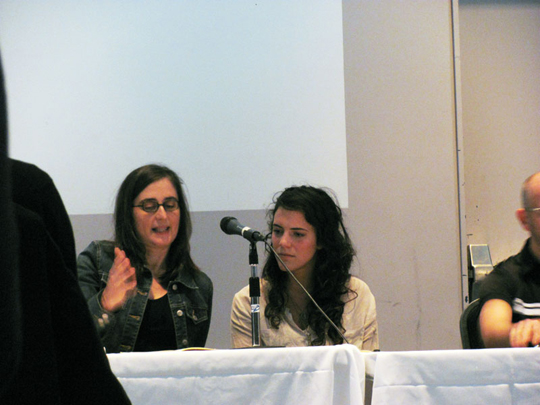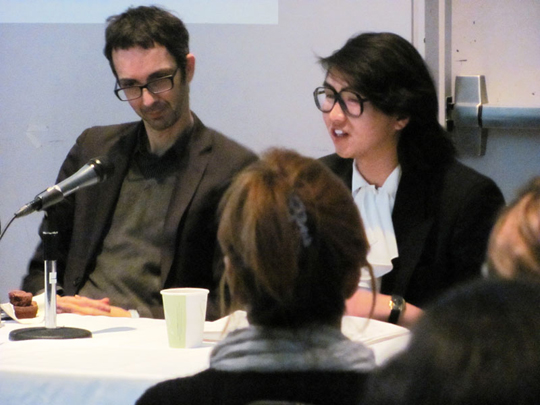
Friday October 21, 2011
KEYNOTE
Christof Migone
MODERATORS
Greg Elgstrand
William Huffman
Sandra Rechico
SPEAKERS
Shannon Anderson
John Armstrong
Jill Caskey
Marnie Fleming
Marla Hlady
Matthew Hoffman
Faye Mullen
Johnson Ngo
Heather Saunders
Denyse Thomasos
Jay Wilson
In partnership with Sheridan Institute of Technology and Advanced Learning





Join us for a mini-conference featuring faculty, students and arts professionals discussing the meanderings of mentorship as it navigates the fields of artistic and curatorial practices, the writing and research skill requirements of art history, and the transition to graduate school.
The title Out of Joint refers to the Art & Art History Program - a joint undergraduate program between Sheridan and the University of Toronto Mississauga. The landmark Canadian program in visual arts (the first of its kind between a college and a university) celebrates its 40th Anniversary this year and is the focus of the current Blackwood exhibition Viva Voce. For more information on the exhibition, click here.
10am - 11am
Keynote: Christof Migone
Moderator: Greg Elgstrand
Shannon Anderson - Marnie Fleming
Jill Caskey - Heather Saunders
11am - 12pm
Moderator: Sandra Rechico
Jay Wilson - Matthew Hoffman
Marla Hlady - Faye Mullen
12pm - 1pm
Lunch
1pm - 2pm
Moderator: William Huffman
John Armstrong – Denyse Thomasos
Christof Migone - Johnson Ngo
UNTEACHABLE: PROVISOS FOR A PARA-PEDAGOGY
by Christof Migone
You can’t teach art, but you can establish some sort of ambiance where art could happen.
You can't teach art, but if you're around artists you
might pick up something.(1)
Both statements come from John Baldessari, renowned artist and reputed art teacher at CalArts and then UCLA until his retirement in 2007. Both statements temper the initial failure of the unteachability of art with similar mitigations. The first claims that one can establish some sort of ambiance where art could happen. This can be read as: the conditions of possibility for the creation of art can be provided. You may provide the framework, but whether art happens or not is accidental. The second, if you're around artists you might pick up something. In other words, one can learn something in art school but only sideways, by happenstance, through adopting a kind of parasitical positioning.
Both statements are provisional and contingent on unknown or unstated conditions: art could happen, you might pick up something. Rather than present this tentativeness as one particular to the teaching of art, it is tempting to read them as an elucidation of all academic pursuits. Although, perhaps art is one of the few disciplines with a heightened self-awareness that the exercise of teaching is fraught, frayed and unable to provide a guarantee of successful learning. Perhaps art as a subject, a practice, a pursuit contains a higher quotient of the unknowable. That agnostic state foregrounds failure—the failure that results in the assertion that "You can't teach art" by the respected art teacher.
But surely all disciplines are prone to the same hubris deflator. The teacher as guardian of all knowledge, even beyond what the teacher knows, is an authoritarian model that has been often been undermined and debunked. In the following passage from What is Thinking?, Heidegger presents one such argument: "Teaching is more difficult than learning because what teaching calls for is this: to let learn. The real teacher, in fact, let's nothing else be learned than—learning. His conduct, therefore, often produces the impression that we properly learn nothing from him, if by 'learning' we now suddenly understand merely the procurement of useful information. The teacher is ahead of his apprentices in this alone, that he has still far more to learn than they—he has to learn to let them learn. The teacher must be capable of being more teachable that the apprentices."(2)
To let learn echoes Baldessari's notion that a fostering environment is key. The other component Heidegger introduces is that in fact the teacher is further behind than the student for the teacher has to be able to learn how to create the conditions that spurs education. The conveyance of information through this whole process is downplayed, or even reneged. The focus is the frame.
Jacques Rancière's oft-quoted scenario from The Ignorant Schoolmaster is apropos here for it outlines a pedagogical methodology predicated on a mutual emancipation of both teacher and student. The emancipation consists on actualizing a self-learning, by one's self, almost despite any attempts by the teacher to teach. The scenario is drawn from an epiphany that Joseph Jacotot has in 1818 upon finding out that his Dutch students were able to learn French even though he himself did not speak Dutch and thus could not communicate with them. They did it on their own with the sole aid of a bilingual text.(3) The lesson, according to Jacotot (and Rancière), was that the necessity of explication was a myth and that comprehending or understanding was not the same as learning.(4) The underlying premise that Rancière derives is that we all come to learning with the same intelligence. The explicating expert does not occupy higher ground. This radical divergence from the Socratic method matches the investigation that Michael Fernandes, the Blackwood Gallery's artist-in-residence this past summer, undertook with participants in the Running with Scissors kid's art camp. He posed the following questions to them: "What have you learned that your parents or teachers haven't taught you?" and "What do you know (by yourself) and how?" This is less a quest for innate knowledge, and more the testing of the hypothesis that learning is dissociable from teaching, or that the learner and the teacher roles are not dissociable—we can teach ourselves.(5)
Now back to art. If teaching art is not possible, does this mean that the presumed corollary, learning art, is also doomed? Or, can one learn art without being taught? Perhaps this is where mentoring comes in. This nebulous para-pedagogical activity remains largely loosely defined, unquantifiable and non-formalized. Mentor is the name of the trusted advisor of Telemachus, the son of Odysseus in Homer's Odyssey. Not so coincidentally the bilingual book Jacotot used to (not) teach French was Fénélon's Les Aventures de Télémaque; this book is the reported origin of when Mentor became mentor.
Before continuing on the subject of the mentor let me address the divide between Art & Art History. Art appended by History seems discernable whereas Art without a corresponding attachment seems naked. Is it the art of art? What is art by itself? To reflect the actuality we could, as many schools do, dub it Studio Art, a place where one practices art. But it is also a place which somehow should still reflect the etymology of the word: studio, from the Latin, studium, to study. So, not just a place but an activity. Both the place where one studies and the act of studying. The two are entwined. Recall Baldessari's ambiance. By extension one could posit that this first Art in the joint Art & Art History, is not solitary, rather it is linked by the ampersand (Art & ?, Art & !, Art & ..., Art & and, etc.) and as such is always accompanied. Not just Art, but always Art & (as with Iain Baxter&).
Is the space for the study of art the same as the space for the practice of art? Certainly the common word used, studio, is the same for both. Perhaps they vary only in the degree of autonomy, the first being more tethered than the other. And perhaps the mentor can be viewed similarly, as a teacher beyond teaching, as a teacher who rephrases the now prevalent institutional catchphrase learning outcomes to learning, how come? A question mark pointing inward, an auto-critique, an awareness and reminder that quantifiable products might be anathema to learning. The mentor as éminence grise, but not wielding power and influence as much giving the floor over to the student. The largely invisible and considerable work is in making the floor available.
Returning finally to Baldessari in What Things Me Now (1982) who declares (though note the brackets): "(I am interested in art as a way of knowing.)"(6) and juxtaposed to artist Pae White's statement, "My favorite art is the art I don't understand",(7) we face an unsurprisingly paradoxical situation. Merging the two together would sound something like: "I am most interested in a way of knowing through art that I don't understand." Perhaps an anecdote by Paul de Man might help in interpreting the above: he recounts losing the ability of driving gracefully ever since he learnt that for every 100 meters one drives one makes at least thirty-six decisions.(8) Sometimes knowledge incapacitates and paralyzes. Art has a tenuous relationship to knowledge. It sometimes prefers ignorance. It sometimes goes beyond by purposely ignoring the point.
The mentor working in the context of art, of the unknowable is at best a para-pedagogue. A para-pedagogy is both beyond and beside. Unquantifiable. Learning to unlearn while learning to let learn. The 1952 prospectus of the legendary Black Mountain College stated that students would receive a fine education if they were just given the option of looking while the teachers educated themselves.(9) The as yet unnamed figure of the autodidact (not to mention amateur) is present as a kind of specter throughout this discussion. Mentoring might just be the shared version of the self-taught. No longer the lone individual, reclusively learning, but the moments where all sides join in the attempt to know "what we don't yet know how to know."(10) In other words, art. The art you can't teach, but the art we can learn.
Shannon Anderson is an independent writer, curator and editor. Recently, she has completed projects for Oakville Galleries, the Varley Art Gallery of Markham, and the Agnes Etherington Art Centre and has written for Canadian Art, C Magazine, and DesignLines.
John Armstrong is a studio professor in Art and Art History, a joint Honours BA program between Sheridan and the University of Toronto Mississauga. Over the past ten years, he has frequently collaborated with Paris artist Paul Collins: their paintings on photographs, videos and publications have been on view in a number of solo and group exhibitions in Canada and Europe. Armstrong has most recently written an essay for Oakville Galleries to accompany Art and Art History Alumna Denyse Thomasos' September 2011 exhibition Kingdom Come.
Jill Caskey is Associate Professor of Art History in the Department of Visual Studies. She also holds a graduate appointment in the Department of Art at the St. George campus of the U of T. She currently serves as Ph.D. Coordinator at the Centre for Medieval Studies, where she is also an an affiliated faculty member.
Gregory Elgstrand is a curator, writer and the Director/Curator of Bohart. He has curated and organized numerous exhibitions across Canada including Happy Medium, a survey of Brian Jungen's drawings, Redwood Downs by David Hoffos, an exhibition of posters and publications produced by Portikus in Frankfurt and group exhibitions such as Futures with Garry Neill Kennedy, Louise Lawler and John Will, and Blue Calgary Sky. He curated the exhibitions Exhibitions and Exhibition in 2006 and 2008 respectively at the Gladstone Hotel in Toronto, Air-Conditioned Jungle at Diaz Contemporary and Nuit Blanche for the City of Toronto both in 2009. Elgstrand was also part of the organizing group behind Reverse Pedagogy 2 that was held in Venice in June 2009. His writings have been published by Canadian Art, C, the Palais de Tokyo, YYZ, the Glenbow Museum and the University of Calgary. Elgstrand recently served as Director of YYZ from 2004 to 2008 and as Director/Curator of the Art Gallery of Calgary (AGC) from 1999 to 2003. Before joining the AGC, Elgstrand worked as Director of Truck in Calgary and from 1995 to 1998 he was Coordinator of Struts Gallery in Sackville, New Brunswick. In 1993, he and his brother, screenwriter, playwright and director Kris Elgstrand, co-founded AH UM Theatre in Vancouver. Elgstrand studied at the Emily Carr College of Art and Design, Simon Fraser University and the Nova Scotia College of Art and Design. Elgstrand is co-editor with Dave Dyment of One for Me and One to Share, a survey of artist multiples (YYZBOOKS, 2011).
Marnie Fleming has a Masters degree in Art History from the University of British Columbia. She has worked at the Vancouver Art Gallery, Vancouver, BC (1981-1986) and Museum London, London, ON (1986-1991). Since 1991 she has been the Curator of Contemporary Art at Oakville Galleries where she has developed a curatorial practice that represents a long-term experiment with the trajectory of site-specific projects within a suburban community. Her research places value on understanding the relationships between identity and the interplay of space/place. Fleming has organized over 200 exhibitions, interventions and outdoor projects. The recipient of grants and writing awards, she has contributed numerous catalogue essays and articles on issues of photography, installation art and new media practices. In addition to recent publications for Oakville Galleries are those produced for the National Gallery of Canada: Is there a there there? (2007) and Angela Grauerholz: The Inexhaustible Image (2010). Fleming was selected as the Ontario juror for the 2011 Sobey Art Awards.
Marla Hlady draws, makes sculpture, works with sites and sounds and sometimes makes video. Hlady's kinetic sculptures and sound pieces often consist of common objects (such as teapots, cocktail mixers, jars) that are expanded and animated to reveal unexpected sonic and poetic properties often using a system-based approach to composition. She has shown widely in solo and group shows. Marla Hlady is represented by Jessica Bradley ART + PROJECTS. She currently teaches undergraduates at the University of Toronto Scarborough and advises graduates at the University of Toronto St. George.
Matthew Hoffman is a designer for Cossette Communications Group in Toronto. His past clients include the Bank of Montreal, Blackberry, Esprit Orchestra and Ironkore, among others. His design for the Grain Farmers of Canada was recently selected for exhibition in RDG Design At Work, 2010.
William Huffman is an arts administrator, curator, educator and writer with a history of extensive involvement on both local and international cultural fronts. Huffman is currently the Associate Director of the Toronto Arts Council and Toronto Arts Foundation; he has been with the organizations since 2002. Huffman has worked with a number of visual arts organizations such as Blackwood Gallery, Arts Toronto, The Power Plant Contemporary Art Gallery, A Space Gallery, Canadian Art Foundation and Art Gallery of Sudbury. He is a past Board member of Mercer Union Centre for Contemporary Art, Ontario Cultural Human Resources Council, Canadian Artists Representation / Le Front des Artistes Canadiens, Alliance Française de Toronto and Parkdale Liberty Economic Development Corporation. He serves as a member of the Curriculum Advisory Committee for Art & Art History, a joint program between Sheridan College and University of Toronto and in 1998, Huffman created the program’s annual William Huffman Award for Excellence in Studio Practice. He currently holds teaching positions with University of Toronto and Toronto School of Art. His past curatorial initiatives include several traveling exhibitions: Aurora: A Survey of New Media Work from Finland (Canada/USA); Head Frame for the 2001 Biennale di Venezia (Italy); Stephen Andrews: the 1st part of the 2nd half (France/Italy/Canada); and traductions (Montréal). Huffman was selected by the Ambassade de France au Canada to curate La Grande Expérience for Toronto's inaugural Nuit Blanche and also functioned as Commissaire of the Mixage: Marseille-Toronto exchange initiative. He was appointed Curator of Exhibitions by the Government of Canada for both G8 and G20 Summits for which he developed major exhibitions of Canadian Contemporary art for each meeting site. Since 2010, Huffman has been Curator-in-Residence with Art Dealers Association of Canada playing a key role in the development of initiatives designed to promote Canadian art at major international art fairs such as The Armory Show (New York), Art Chicago and Art Toronto. In 2012 and in partnership with Textile Museum of Canada and Embassy of Finland, Huffman will launch an initiative exploring the links in a history of design between Helsinki and Toronto.
Christof Migone is an artist, curator and writer. He co-edited the book and CD Writing Aloud: The Sonics of Language (Los Angeles: Errant Bodies Press, 2001) and his writings have been published in Aural Cultures, S:ON, Experimental Sound & Radio, Musicworks, Radio Rethink, Semiotext(e), Angelaki, Esse, Inter, Performance Research, etc. He obtained an MFA from NSCAD in 1996 and a PhD from the Department of Performance Studies at the Tisch School of the Arts of New York University in 2007. He has curated a number of events: Touch that Dial (1990), Radio Contortions (1991), Rappel (1994), Double Site (1998), stuttermouthface (2002), Disquiet (2005), START (2007),STOP.(2008), and Should I Stay or Should I Go (Nuit Blanche 2010 - Zone C), and eleven others for the Blackwood Gallery. He has performed at Beyond Music Sound Festival (Los Angeles), kaaistudios (Brussels), Resonance FM (London), Nouvelles Scènes (Dijon), On the Air (Innsbruck), Ménagerie de Verre (Paris), Experimental Intermedia (NYC), Méduse (Québec), Images Festival (Toronto), Send+Receive (Winnipeg), Kill Your Timid Notion (Dundee), Victoriaville Festival, Oboro, Casa del Popolo, Théâtre La Chapelle, etc. His installations have been exhibited at the Banff Center, Rotterdam Film Festival, Gallery 101, Art Lab, eyelevelgallery, Forest City Gallery, Studio 5 Beekman, Mercer Union, CCS Bard, Optica. A monograph on his work, Christof Migone - Sound Voice Perform, was published in 2005. In 2006, the Galerie de l'UQAM in Montreal presented a mid-career survey of his work accompanied by a catalog and a DVD entitled Christof Migone - Trou. He lives in Toronto and is a lecturer at the University of Toronto Mississauga and the Director/Curator of the Blackwood Gallery.
Often within a dissection of space, Faye Mullen employs the body to speculate theories concerning absence, loss and limitation. Her phenomenological investigations are articulated through video,performance, sculpture and installation. Mullen grew up in the Niagara Region, Canada. She studied studio art with an emphasis on sculpture at l'école National Supérieure des Beaux-Arts in Paris and at the Ontario College of Art & Design, Toronto where she received her BFA. Currently, a SSHRC award supports her research in the MVS-Studio program at the University of Toronto. Mullen has exhibited internationally in solo and curated group exhibitions in Paris, Seoul, Portland, Linden and Toronto and has participated in international artist residencies in Canada and South Korea. She is the founder of minnow & bass Gallery, a nomadic artist run space. Currently, she situated her practice in Toronto.
Johnson Ngo is a Toronto-based artist who works in performance and sculpture. Ngo's research explores connections and disjunctions between his gaysian identity and Western queer culture. He recently participated in LEITMOTIFS for Nuit Blanche, a commission for the Bernie Miller Lightbox at the Blackwood Gallery, and the Bloor Alternative Art Fair for the BIG on Bloor Festival. Ngo also plays a facilitative role at various art institutions in Toronto, such as the Art Gallery of Ontario, TAIS, and Reel Asian Film Festival and serves as the current chair of Trinity Square Video Board of Directors.
Sandra Rechico’s studio practice in drawing and installation is currently focused on maps, routing, wayfaring and navigation. She has taught at the Ontario College of Art, The University of Toronto and the Nova Scotia College of Art and Design. She is currently an Associate Professor at the University of Guelph. Her work has been featured in numerous publications and is held in many public and private collections. Sandra Rechico has exhibited across Canada, in Europe and Australia. She has also worked in collaboration with Gwen MacGregor over the past 4 years. They exhibited Backtrack at the A trans Pavilion in Berlin this past sumer and will be part of Placemarkers at Dalhousie Gallery in Halifax in 2012.
Heather Saunders is a graduate of the Art and Art History program, and she holds Masters degrees in the History of Art and Library and Information Studies from the University of Toronto. She has worked at commercial, not-for-profit, and public galleries, including the National Gallery of Canada. She relocated recently from New York, where she worked as a faculty art librarian at Purchase College. She has exhibited her work in Canada and the US, and she writes a companion blog of feminist art criticism called Artist in Transit.
Denyse Thomasos was born in Trinidad in 1964 and grew up in Toronto, Canada and has been living and working in US since completing her MFA at Yale University's School of Art in 1987. She attended the Art and Art History Program, a combined program with Sheridan College and the University of Toronto from 1983 to 1987. She has shown both nationally and internationally and is represented by Lennon, Weinberg (Chelsea), the Olga Korper Gallery (Toronto) and The Brand New Gallery (Milan). Thomasos has had a number of solo exhibitions and has been reviewed in many of the major national and international art periodicals including ArtForum, Art in America, Canadian Art, the Globe and Mail and New York Times. Over the years she has been consistently recognized, winning over forty awards and artist residencies including a Guggenheim (1997), a PEW Fellowship (1995), Bellagio residency (2001), Yaddo Residency, Joan Mitchell Award (1998) and NYFA (2008) and a number of Canada Council project grants. Most recently she was named the first recipient of the McMillan/Stewart Award, recognizing unique and outstanding contributions made by women artists. In 2006 Thomasos was commissioned to complete a large-scale wall work at the Art Gallery of Ontario in honor of the Frank Gehry's renovation project. The museum acquired a major work 'Metropolis' that was premiered at the opening of the building. She has just completed a wall work installation exhibition at the Oakville Galleries entitled 'Kingdom Come', followed by her first solo exhibition in Milan in 2012. Thomasos is a Professor of Painting at Rutgers University, Newark Campus and currently lives and works in the East Village, NYC with her husband and daughter.
Jay Wilson is a Toronto artist (sculptor), designer and educator. He is a full-time professor of design in the Art and Art History program, a joint program between the University of Toronto Mississauga and Sheridan College. He has an Honours degree in Wildlife Biology and Statistics from the University of Guelph as well as his diploma from The Ontario College of Art and Design and his MFA from York University. Wilson has shown both locally and internationally, most notably in the Havanna Biennale in 2003 and as part of a North American survey show in Bologna, Italy entitled Officina America curated by Renato Barill in 2002. He has received creation, research and exhibition assistance grants from the Toronto Arts Council, the Ontario Arts Council and the Canada Council for the Arts. He served on the Board of Mercer Union and as president from 2000-2002 and was the inaugural recipient of the Toronto Friends of the Visual Arts Artist Prize. He has received grants from the Canada Council for the Arts, the Ontario Arts Council and the Toronto Arts Council. He is represented by KWT Contemporary in Toronto. His design and art practices are a mix of conceptual considerations and play. His artistic direction is structured, but often full of segues, spontaneity and contradiction. Lately his practice includes building labour-intensive structures made of toothpicks that involve a community of collaborators that help complete the work.
In partnership with the Faculty of Animation, Arts and Design, Sheridan Institute of Technology and Advanced Learning and the Department of Visual Studies, University of Toronto Mississauga and generously supported by the Canada Council for the Arts.



Viva Voce: 40th Anniversary of the Art & Art History Program
September 14 - October 23, 2011